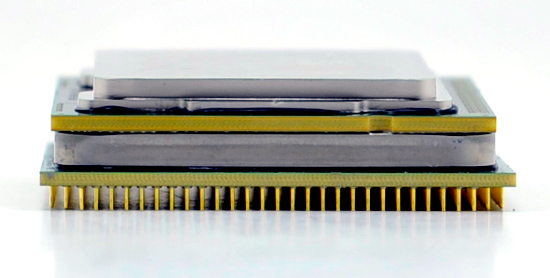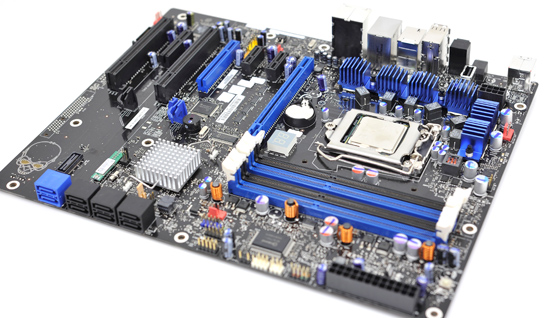Intel's Core i7 870 & i5 750, Lynnfield: Harder, Better, Faster Stronger
by Anand Lal Shimpi on September 8, 2009 12:00 AM EST- Posted in
- CPUs
Final Words
I'll start this conclusion with what AMD must do in response to Lynnfield. The Core i5 750 is a great processor at $196, in fact, it's the best quad-core CPU you can buy at that price today. In nearly every case it's faster than AMD's Phenom II X4 965 BE, despite the AMD processor costing almost another $50. Granted you can probably save some money on an integrated 785G motherboard, but if you're comparing ~$120 motherboards the AMD CPU is simply overpriced.

Lynnfield (top) vs. Phenom II (bottom)
Luckily, the solution isn't that difficult. AMD needs to lower prices. The problem is that AMD has too many products below $200 already. The Phenom II X3 and X4 series both exist below $200 and rumor has it that AMD is also going to introduce a quad-core Athlon II somewhere down there. Lynnfield's arrival causes a lot of price compression on AMD's side. The most AMD should sell the 965 BE for is $199, but if it is to remain competitive the chip needs to be priced much lower. That doesn't leave much room for other AMD CPUs. On the bright side, this could force AMD to simplify its product lines again (similar to what it has quietly been doing already).

The next thing that the Core i5 750 does is it finally ends the life of LGA-775. Just as was the case with AMD, the Core 2 Quad Q9650 is easily destroyed by the Core i5 750 and at a lower price. With significantly lower motherboard costs than the LGA-1366 chips, the Core i5 750 can actually compete in the high end LGA-775 space. It's only a matter of time before the sub-$200 LGA-775 parts are made obsolete as well.
Lynnfield power consumption is just excellent, these are the most power efficient quad-core CPUs we've ever tested. They use less power at idle than similarly clocked dual-core processors and under load they deliver better performance per watt than any of their closest competitors. Later this year we'll see 32nm dual-core Westmere start to ship for notebooks. I don't have performance data but I'd expect that early next year will be the perfect time to buy a new notebook.
Can you tell that I like the Core i5 750? Again, at $196 you can't find a better processor. Intel did its homework very well and managed to deliver something that kept AMD in check without completely upsetting the balancing of things. There's no technical reason that Intel couldn't have enabled Hyper Threading on the Core i5, it's purely a competitive move. A Core i5 750 with HT would not only defeat the purpose of most of the i7s, but it would also widen the performance gap with AMD. Intel doesn't need to maintain a huge performance advantage, just one that's good enough. While I'd love to have a 750 with HT, I'd still recommend one without it.
The Core i7 870 gets close enough to the Core i7 975 that I'm having a hard time justifying the LGA-1366 platform at all. As I see it, LGA-1366 has a few advantages:
1) High-end multi-GPU Performance
2) Stock Voltage Overclocking
3) Future support for 6-core Gulftown CPUs
If that list doesn't make you flinch, then Lynnfield is perfect. You'll save a bunch on a motherboard and the CPUs start at $196 instead of $284. We didn't have enough time with our Core i7 860 to include performance results here but my instincts tell me that at $284 that'll be the Lynnfield sweetspot. You get excellent turbo modes and Hyper Threading, without breaking $300.
Speaking of turbo, I'd say that Intel is definitely on to something here. The performance impact was small with Bloomfield, but turbo on Lynnfield is huge. My tests showed up to a 17% increase in performance depending on the workload, with most CPU-influenced scenarios seeing at least 9 or 10%. The turbo mode transitions happen fast enough to accelerate even simple actions like opening a new window. OS and application responsiveness is significantly improved as a result and it's something that you can actually feel when using a Lynnfield machine. It all works so seamlessly, you just always get the best performance you need. It's like Intel crammed the best single, dual and quad-core processors all into one package.
Perhaps that's what kept me from falling in love with Bloomfield right away. It was fast but in the same way that its predecessors were fast. If you didn't have a well threaded application, Bloomfield wasn't any better than a similarly clocked Penryn. Lynnfield's turbo modes change the game. Say goodbye to tradeoffs, the Core i5 and Core i7 are now fast regardless of thread count. It speed that is useful, it speed that you can feel, it's what truly makes Lynnfield the best desktop microprocessor of 2009. It's not just faster, it's smarter, it's better. It's why today's title borrows from Daft Punk and not Star Wars; it's not more of the same, it's something futuristic and new.
Lynnfield shows us the beginning of how all microprocessors are going to be made in the future. Even AMD is embracing turbo, we'll see it with Fusion in 2011. Extend turbo to its logical conclusion and you end up with something very exciting. Imagine a processor made up of many different cores, large and small, CPU and GPU. Each one turning on/off depending on the type of workload, and each running as fast as possible without dissipating more heat than your system can handle.
My only two complaints with Lynnfield are that the chips do require additional voltage (above stock) to overclock and of course the lack of Hyper Threading on the Core i5. It doesn't ruin the processor, but it gives us something to wish for.
Our work is never over.










343 Comments
View All Comments
snakeoil - Tuesday, September 8, 2009 - link
and the cherry on top of the piecore i5 750 and core i3 don't support virtualization.
http://www.virtualization.info/2009/07/intel-core-...">http://www.virtualization.info/2009/07/intel-core-......
that's fantastic, colossal intel.
what's wrong with intel
Anand Lal Shimpi - Tuesday, September 8, 2009 - link
Intel VT-x is supported by the Core i5 750:http://processorfinder.intel.com/details.aspx?sSpe...">http://processorfinder.intel.com/details.aspx?sSpe...
Take care,
Anand
snakeoil - Tuesday, September 8, 2009 - link
sorry incomplete linkhttp://www.virtualization.info/2009/07/intel-core-...">http://www.virtualization.info/2009/07/...core-i3-...
AssBall - Tuesday, September 8, 2009 - link
What are you talking about? These overclock FINE; read the article. 4 Ghz. Anyone that is gonna overclock bloomfield or lynnfield seriously is opting for an aftermarket HSF, so don't bother arguing that. Your comment doesn't make any sense.TA152H - Tuesday, September 8, 2009 - link
You missed the point.When you overclock the processors, you change the characteristics of turbo mode. Consequently, the big advantage of the Lynnfield disappears, and they run at the same clock speed, instead of the Lynnfield at a higher clock speed.
Do you understand now?
eternalfantasy - Tuesday, September 8, 2009 - link
lolemogoinginstyle - Tuesday, September 8, 2009 - link
"There are better sites that have answered these questions. I used to like this site, but this review is another disappointment. "Just how is that Tom's Hardware gig working out for you? I noticed your name was not on any of their launch reviews since you seem to be an expert on the subject. Why is that?
TA152H - Tuesday, September 8, 2009 - link
Thanks for asking.When I have time, I will be writing another article, which they hopefully will use, but to be honest, the time it takes to write an article, at least a well-written one, takes an enormous amount of time and effort.
Getting and verifying data is only part of it. Writing it in an artistic an interesting way is very time consuming, and, at least for me, requires many rewrites of the same pages. Each page took me at least five hours, some many more, plus the upfront time of deciding which pages to write, which probably took at least 30 hours of research.
The editor of Tom's wrote their articles, and it's clear to see the much more thorough review he did. Personally, I like him and occasionally do communicate with him, and I probably would like Anand too, since he seems like a good fellow, but I have no real affiliation with their site. If I write an article they like, they might publish it. That's it.
But, honestly, if you do it for money, you're a fool. It takes WAY too much time for that. You really have to want to do it, and the money is secondary.
goinginstyle - Tuesday, September 8, 2009 - link
So it took you five hours a page to do a copy and paste from Wikipedia on that so called article of yours? I read the Tom's P55 article, not seeing how it was any more thoughtful than the one here or at Tech Report. At least Anand did some searching and reported on items like PCIe clocking/voltage requirements that I noticed was not mentioned at Toms.Your only motive for these posts is to try and look impressive at Toms in hopes that they will publish another boring piece of dung from you. Otherwise, your complaints here are just as justified at Toms or TR, yet you are not posting at either site. That is why it is so obvious as to what you are up to with the flame bait comments.
TA152H - Tuesday, September 8, 2009 - link
I never even looked at Wikipedia, since I don't consider it a valid source of information.Why do you talk about things you don't know about. In fact, some people used Wikipedia to argue some points with me. I made a point never to look at those pages.
But again, what have you done with your, except produce carbon dioxide and speed up global warming? You seem pretty worthless to me.